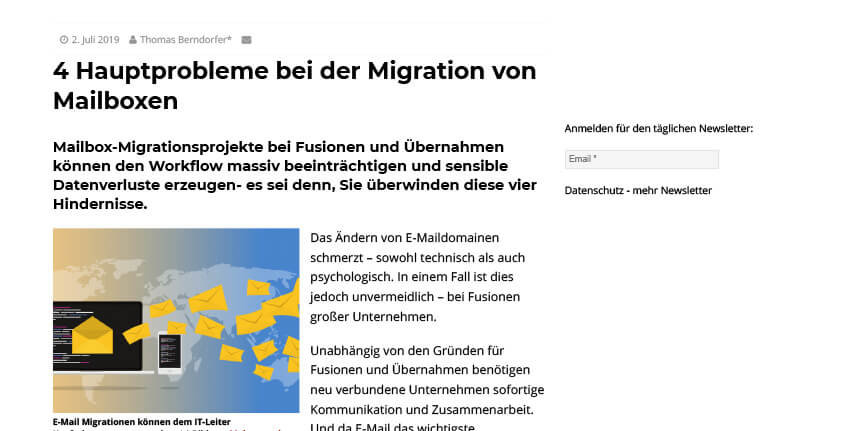4 main issues to solve during mailbox migration
ComputerWelt
Mailbox migration projects can harm the workflow and put sensitive data at risk – unless you overcome these four roadblocks
Changing email domains hurts - both technically and psychologically. But it is inevitable in one case – during mergers and acquisitions.
Whatever the reasons behind M&A, newly joined entities need instant communication and collaboration. And since email is the main communication and collaboration tool in the world, getting discordant systems working together from day one, post-close is a top priority. This includes having full calendar interoperability for scheduling meetings, having updated contacts and tasks in place and being able to work smoothly as before.
There are various scenarios for email migration projects:
Acquisition: a bigger company needs to integrate the smaller company’s calendar and email system on their own;
Merger: two companies form one email system out of two;
Split: one email system needs to migrate to two different ones;
Consolidation: several smaller companies require migrating into fewer mailbox systems.
Why mailbox migration project under M&A is so difficult
When companies merge, they probably have similar or adjacent areas of business interest. However, from a technical viewpoint, they can be absolutely different. Below there are main hurdles for IT professionals when managing an M&A project.
1. Your Exchange Servers may be hosted in different places
Some corporate mailbox infrastructures like Exchange are deployed on-premises, some are outsourced as SaaS, and others are hosted elsewhere in the cloud.
2. You may have different versions of Exchange servers
Oftentimes organizations have different versions such as Exchange 2010, Exchange 2013, Exchange 2016, Exchange Online (independent mail server or as part of Office 365), or Exchange 2019. Thus, migrating mailboxes between the various versions may be very stressful for some IT teams.
3. You’ve chosen Office 365 as the ultimate location for mailboxes
Many companies undergoing the M&A process consider migrating to Office 365 as the ultimate solution. However, they can be hindered by such circumstances as the need to perform Office 365 tenant to tenant migration or even migrate from on-prem Exchange to Office 365, or vice-versa.
4. You can’t afford any downtime
When everything seems to be falling apart during an M&A “adventure”, experiencing downtime of mailboxes and calendars is completely unacceptable. But unfortunately, enterprises suffer even through this.
Allow time and budget for an IT migration
Interestingly, when planning an acquisition or a merger, the company management takes into account many things but very often leaves the technical aspect for the last stages. However, a chaotic approach to IT integration can drain value from an acquisition. Without detailed planning, these critical migration projects can harm the workflow and put sensitive data at risk.
To ensure a smooth migration of mailboxes, companies require synchronization software to moves mailboxes and data, without harming business productivity.
But I don’t have the right software for mailbox migration
Microsoft provides ready-to-use solutions for Exchange server migrations, and oftentimes they are enough to cover the needs under M&A. But there are other instances when standard software is helpless. For example, when standard Exchange Server Migration cannot be done because the client has two independent Exchange Servers in different Active Directory (AD) and mail domains. This migration is not possible in one step. So, the two servers need to coexist while the users are switching to the new server.
In this case, you can know-hows of Independent Software Vendors which solve most complicated issues smoothly and for a reasonable cost.
Having email up and running – and showing a fully populated calendar, letters, contacts, tasks, etc. – is critical for business professionals, and may define if a merging process is a win or a loss.
